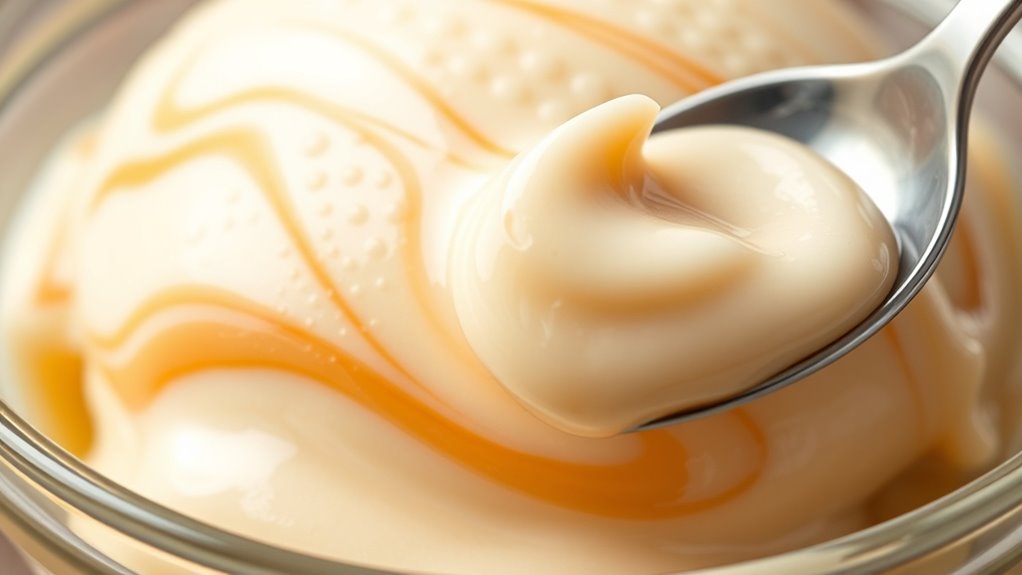Lactose-free gelato is made from dairy but treated with enzymes like lactase, which break down lactose into simpler sugars, making it easier to digest. This process doesn’t remove or replace dairy, so you’ll still enjoy the rich, creamy texture and authentic flavor of traditional gelato. If you’re curious about how this enzymatic treatment works and its benefits, there’s more to discover about this tasty, digestive-friendly option.
Key Takeaways
- Lactose-free milk gelato is made from dairy milk with added enzymes, not from dairy-free alternatives.
- Enzymes like lactase break down lactose into simpler sugars, improving digestibility without removing dairy.
- The enzymatic process does not significantly alter the milk’s flavor, texture, or nutritional profile.
- Lactose-free gelato offers the same creamy, authentic dairy taste as traditional gelato.
- This processing allows consumers to enjoy dairy flavors with better digestion, but it remains dairy, not dairy-free.

If you’re craving a delicious, creamy treat without the discomfort of lactose, lactose-free milk gelato is the perfect choice. Many people assume that “lactose-free” means dairy-free, but that’s not always accurate. Lactose-free milk gelato is made from dairy, but it undergoes a special process to make it easier to digest for those with lactose intolerance. This process involves adding enzymes that break down lactose into simpler sugars, which your body can absorb more easily. As a result, you get the rich, creamy flavor of traditional gelato without the bloating, gas, or stomach upset that often come with lactose digestion issues. Understanding how enzyme treatments modify dairy products can help consumers make informed choices.
Understanding how enzyme-treated milk gelato fits into the broader category of dairy alternatives helps clarify this. While dairy alternatives like almond, soy, or coconut milk are completely free of lactose and dairy proteins, lactose-free milk is still a dairy product. The key distinction is that lactose-free milk retains all the nutrients and authentic flavor of cow’s milk but with the lactose already pre-digested. This makes it an excellent option if you’re looking to enjoy dairy-based gelato but need to avoid the natural sugar that lactose represents. You don’t have to sacrifice taste or texture; lactose-free milk gelato offers the same smoothness and creaminess you expect from regular gelato, just with added convenience for your digestive comfort.
Choosing lactose-free milk gelato doesn’t mean you’re missing out on the nutritional benefits of dairy, such as calcium, protein, and vitamins. It’s simply processed differently to accommodate your body’s needs. The enzymes involved in the process—mainly lactase—break down lactose into glucose and galactose, which are easier for your body to digest. This enzymatic treatment doesn’t alter the flavor substantially, so you still enjoy the authentic, creamy taste that makes gelato so irresistible. Plus, since it’s made from dairy, it provides a familiar experience for those who prefer traditional dairy flavors but need a gentler option.
In essence, lactose-free milk gelato bridges the gap between dairy indulgence and digestive comfort. It’s an example of how modern food processing can cater to specific dietary needs without compromising on taste and quality. So, if you’re sensitive to lactose but still crave that luscious, creamy gelato, opting for enzyme-treated milk is a smart choice. You get the best of both worlds: the satisfying richness of dairy and the ease of digestion that comes with dairy alternatives designed to support your health.
Frequently Asked Questions
How Is Enzyme-Treated Milk Gelato Different From Traditional Gelato?
Enzyme-treated milk gelato differs from traditional gelato mainly in ingredients and texture. You’ll notice a smoother, creamier texture because enzymes break down lactose, making it easier to digest. Unlike traditional gelato, it uses enzyme-treated milk instead of fresh milk, which can alter the flavor subtly. While the ingredient list changes, the overall experience remains rich and satisfying, but the texture comparison shows a subtle difference—more velvety and less icy.
Can Lactose-Free Gelato Still Contain Trace Amounts of Dairy?
Think of lactose-free gelato like a carefully crafted symphony—smooth and sweet, yet sometimes with a faint whisper of the original tune. Due to trace contamination during manufacturing processes, tiny dairy residues might still sneak in, even when it’s labeled lactose-free. So, if you’re sensitive, remember that these small traces can linger, making it essential to check labels and choose products that prioritize strict separation to keep your experience safe and delightful.
Are There Any Health Benefits to Enzyme-Treated Milk Gelato?
You might wonder if enzyme-treated milk gelato offers health benefits. It can aid digestion by breaking down lactose, making it easier on your stomach, especially if you’re lactose intolerant. However, if you have dairy allergies, be cautious, as trace amounts might still trigger reactions. While enzyme treatment improves digestibility, it doesn’t eliminate dairy proteins, so allergy considerations remain essential.
Is Enzyme Treatment Used in Other Dairy Products Besides Gelato?
Many believe enzyme treatment is exclusive to gelato, but it’s actually common in dairy processing. Enzyme applications are widely used in making cheese, yogurt, and even butter, helping improve texture, flavor, and digestibility. By breaking down lactose or proteins, enzymes make dairy products more accessible for those with sensitivities. So, if you’re curious, you’ll find enzyme treatment plays a significant role across various dairy products beyond just gelato.
Does Enzyme-Treated Milk Gelato Have a Different Taste or Texture?
You might notice a slight flavor variation or texture difference in enzyme-treated milk gelato compared to traditional gelato. The enzyme process can make the texture creamier and smoother, but some people find the flavor subtly altered, often described as more neutral or slightly sweeter. Overall, it’s a small change, and many enjoy the lighter mouthfeel, though individual preferences vary.
Conclusion
So, next time you indulge in lactose-free milk gelato, remember—it’s not just dairy-free, it’s a miracle in every spoonful! Thanks to enzyme treatment, you get to savor the creamy, dreamy taste without any lactose baggage. It’s like magic turned into dessert, allowing you to enjoy every bite guilt-free. Don’t settle for less—embrace this revolutionary treat and experience a dessert revolution that’ll leave your taste buds dancing and your friends in awe!









